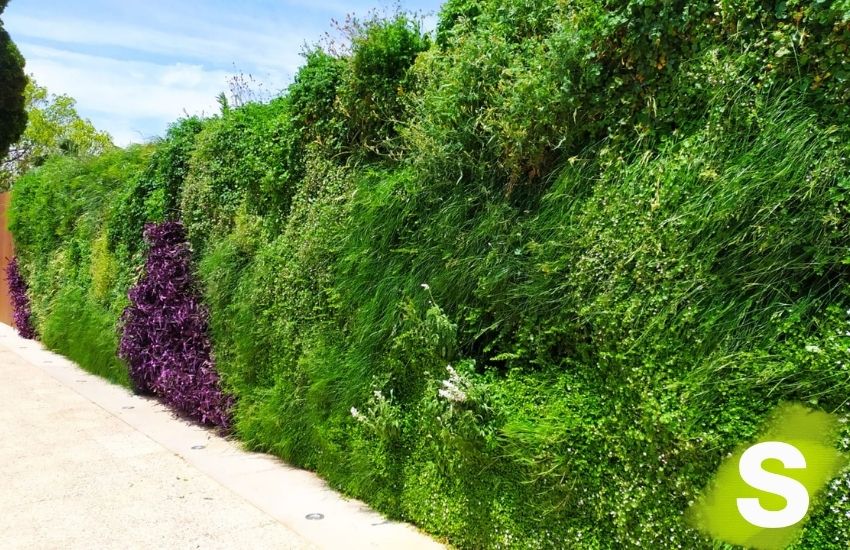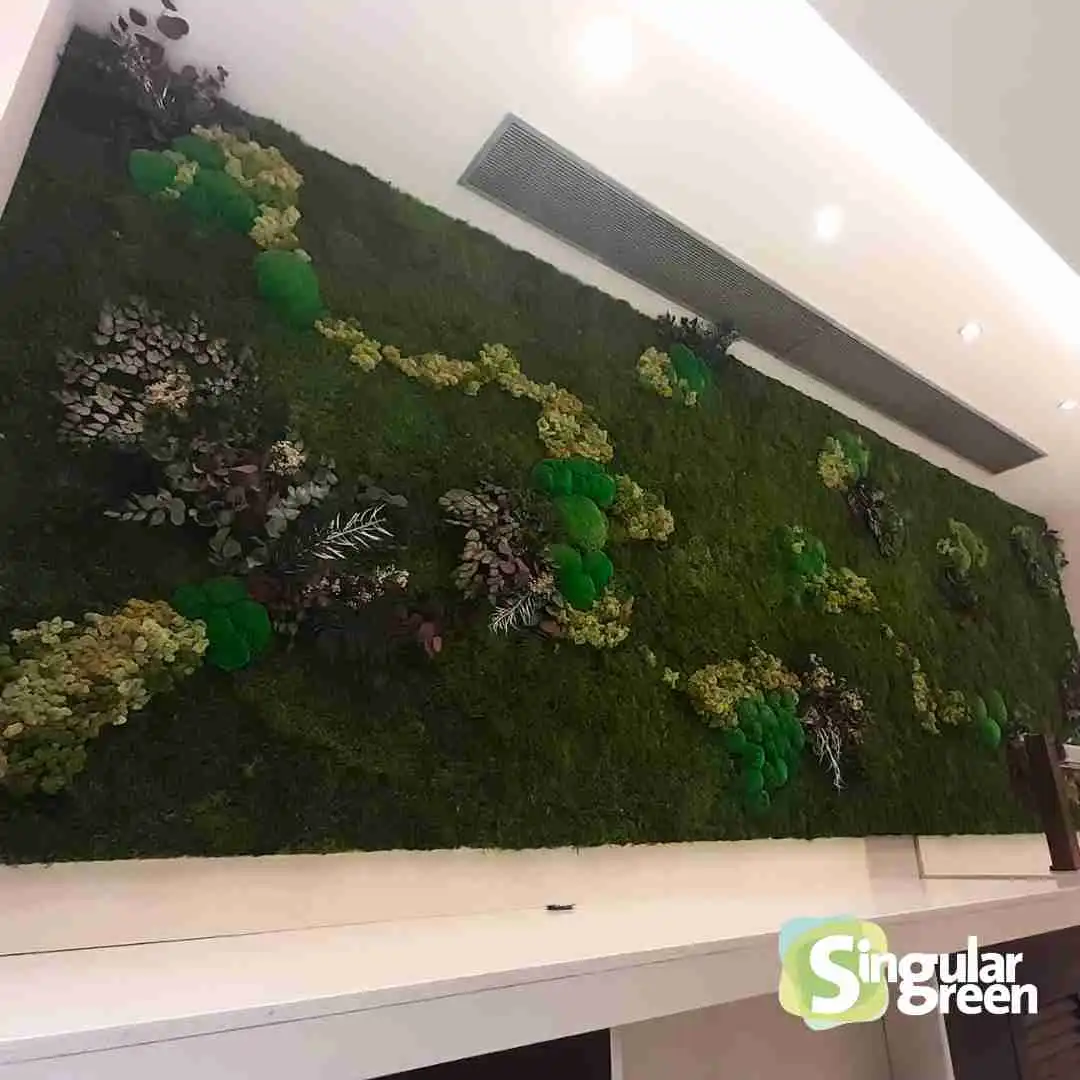At SingularGreen, we have learned over the years by utilising various systems for outdoor and indoor vertical gardens.
Hydroponic systems are the ones that adapt to all situations and requirements, simply by making certain adjustments for each scenario.
The F+P system is the one we began using to create outdoor living walls, both for medium and large surfaces, as it is the system that best withstands extreme temperatures, whether hot or cold.
Today, it has become an excellent all-round option that we recommend for all situations.

Here is an explanatory video about the F+P system used for creating outdoor vertical gardens.
Composition of F+P for Outdoor Vertical Gardens
This system consists of:
1. SG-PC35 Panel
The system is made up of a panel of 100% recycled cellular PVC. The SG-PC35 panel is a cellular panel equipped with an air chamber that acts as a safety system.
n this way, we ensure the watertightness of the green wall.
This panel features an air chamber that guarantees the system’s waterproofing; that is, if water penetrates the first layer of the panel, it will move to the air chamber of the PVC itself. From there, any filtered water will flow to the bottom of the vertical garden, where it is collected.
Thanks to this cellular panel, the supporting wall will never receive water from the vertical garden.
Aluminium Joining Piece:
Each panel comes with an aluminium joining piece. This component not only serves as a connector with the next panel but also redirects water towards the vertical garden, maintaining moisture and maximising the use of water employed for irrigation.
It is of utmost importance to us that water can never enter the back of the garden and wet the façade. To achieve this, we have developed the SG-PC35 panel, which ensures the watertightness of the installation.
2. Inert Substrate SG-L40-100
The SG-L40-100 panel is placed on top of the SG-PC35 panel using mechanical fastening. This panel is made of rock wool specifically designed for the cultivation of vertical gardens.
This inert substrate has the ability to:
- Retain water.
- Ensure aeration.
There are many materials that retain water, such as the material used in our F+P system. However, other water-retaining materials run the risk of becoming waterlogged if overwatered.
The advantage of the specific rock wool is that we can water it almost as much as we like. In fact, we can water it ten times more than the recommended amount for the particular vertical garden, and this substrate will still ensure the necessary aeration.
Remember always that more plants are killed by overwatering than by underwatering.
This rock wool substrate also features a series of perforations designed to accommodate plants. These holes, created by us, allow for adjustments in planting density, tailoring it to the specific needs of the project or the client.
3. Irrigation System SG-A24
Our outdoor vertical gardens using the F+P system are equipped with a hydroponic irrigation system that is scaled to the size of the vertical garden, featuring automated control for both watering and fertilisation.
The panels are designed to fit seamlessly together, ensuring that the inert substrate remains in direct contact with one another.
This direct contact between panels means that only a double SG-R16 tubing, with integrated self-compensating drippers, needs to be installed at the top of the vertical garden, concealed within the designated space for it.
Therefore, this connection between panels allows water to distribute by gravity from the top of the vertical garden to the bottom.
This makes irrigation maintenance very straightforward. Furthermore, in the event of any irrigation failure, we will only have two pipes located in an easily accessible upper area.
At SingularGreen, we also deem it essential to install remote control and management elements for the irrigation system in all our F+P vertical gardens, as they are generally large-scale gardens installed outdoors.
This way, we always have information about the current status of the irrigation system and its historical data, which is crucial for the proper functioning of the vertical garden.
4. Vegetation
To determine the finish of the vertical garden, we make a specific selection of species based on the climatic zone and the project characteristics, using a density of 20-40 plants per square metre.
This type of F+P vertical garden for outdoor use, with inert substrate, features holes in a B-28 format where the plants must be inserted. Therefore, it is ideal to choose plants that fit this format.
The B-28 tray is an intermediate size between newly germinated nursery seedlings and the plant transplanted into its final pot. Each of these plants has a root ball that is slightly larger than the hole where it will be placed.
The size of the plants in the B-28 tray is optimal for use in vertical gardens, as they adapt very quickly—both their root system and aerial part—to the new location and horizontal orientation.
Additionally, the pot format is slightly taller than the depth of the hole, so the neck of the plant’s root will protrude a little. This is important because most fungal issues (caused by excess moisture) occur at the root neck.
If this part of the plants slightly protrudes, they will be better aerated and have a lower chance of contracting fungal diseases.
Assembly of the F+P Vertical Garden for Outdoor Vertical Gardens
The advantage of these gardens lies in the fact that we can carry out a pre-assembly in our workshop, thus streamlining the “on-site” installation of the system and considerably reducing installation times.
The steps we follow are as follows:
1. SG-PC35Panel
We use the SG-PC35 panel, to which we screw a Z-shaped aluminum piece at the bottom.
2. Fixing the Panels
Using a plastic washer and a metal screw, we secure the SG-L40-100 plant substrate panels to the SG-PC35 panel.
3.Installation on the Surface
The installation surface varies depending on the project; that is, the vertical garden can be installed directly onto the wall or on a specific structure designed for it.
These vertical gardening panels come fully prepared for direct installation, as they feature a specific air chamber that eliminates the need for on-site fabrication.
When placing the panel on the surface, we use a level to ensure the panel is straight, and then it is secured to the surface with metal screws.
4. Planting of Plant Species
Placement of plant species in the holes created in the SG-L40-100 panels according to a pre-designed layout.
Planting System
This planting system is one of the simplest in the world of vertical gardening.
It does not require any specific tools. You simply take the pot and place it in the garden, and in no time, you have finished planting the vertical garden panel.
The plant is relatively small in size (it still needs to grow), and this is important for the root development to occur in the rock wool substrate.
It’s also important to note that the smaller the plant, the better it will develop later in the vertical garden, as it grows from a young state in the conditions of the system.
Replacement or Change of Species in a Vertical Garden
If at any point you wish to add a new plant or replace an existing species, the process is very straightforward.
Using a utility knife, cut around the root at the perforation, remove the old plant, and insert the new one.
It is important to remember that the substrate is not just the hole where the plant was placed; rather, the substrate encompasses the entire SG-L40-100 panel. Therefore, you should be aware that the roots of the removed plant will be spread throughout the inert substrate.
Advantages of F+P Outdoor Vertical Gardens Compared to Other Systems
Selection of Species
Thanks to the aeration provided by the inert substrate, we can plant all kinds of species. This means we can include everything from ferns to species that require less water, such as rosemary and lavender.
As a result, we can mix species that do not have exactly the same water needs and irrigate them simultaneously with the same amount of water.
Lightweight
This system is very lightweight, composed of panels that can be handled by a single person, even when the panel is already planted.
Durability
This is a semi-hydroponic system where the SG-L40-100 panel serves as the substrate, and nutrients are supplied through irrigation.
The SG-L40-100 panel is made of fiberglass, which does not chemically interact with either the nutrients or the plant roots. This makes it a very durable vertical garden.
If we encounter any issues, such as excess salts due to over-fertilization or because the local water quality is poor, we can wash the substrate and restart the vertical garden.
Maintenance
Thanks to the design of the panels and the simplicity of the irrigation system, maintenance is very straightforward.
Technical Information for Outdoor Vertical Gardens
If you would like more technical information about the F+P system, you can download it from our download portal.
Training
If you’re interested in learning more about vertical gardens, below you will find information about our online vertical gardens course.

If you have any questions or inquiries, please feel free to contact us. We will be happy to assist you.







